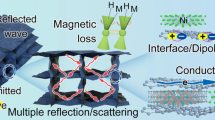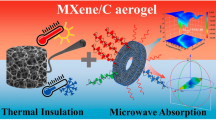Abstract
The effective optical constants that describe the interaction between electromagnetic wave and particulate composite are calculated based on effective medium theory and Mie theory. The negative refractive phenomenon is compared between the Ge-particle-dispersed LiTaO3 composites and Ag-particle-dispersed LiTaO3 composites. It is indicated that the negative refraction phenomenon for semiconductor Ge particulate composite occurs in higher frequency range than that of noble Ag particulate composite. By take the Ge particulate composite as an example, the influence of size and number density of spherical particles on the negative refraction phenomenon is analyzed. It is indicated that the frequency range where negative refraction phenomenon occurs can be shifted to higher frequency by adjusting these two influencing factors.
Similar content being viewed by others
References
Liu G P, Xuan Y M, Han Y G, et al. Investigation of one-dimensional Si/SiO2 photonic crystals for thermophotovoltaic filter. Sci China Ser E-Tech Sci, 2008, 51(11): 2031–2039
Shuai Y, Jiang L, Che Z Z, et al. Near field radiative heat transfer about nanoparticles and semi-infinite media (in Chinese). J Eng Thermophys, 2009, 30(2): 279–281
Fu C J, Zhang Z M, Tanner D B. Energy transmission by photon tunneling in multilayer structures including negative index materials. J Heat Transfer, 2005, 127(9): 1046–1052
Fu C J, Zhang Z M, Tanner D B. Planar heterogeneous structures for coherent emission of radiation. Opt Lett, 2005, 30(14): 1873–1875
Huang Y, Cui Y, Wang J. Thermal emission characteristics of a negative index semitransparent thin film (in Chinese). J Infrared Millim Waves, 2009, 28(4): 289–292
Pendry J B, Holden A J, Robbins D J, et al. Magnetism from conductors and enhanced nonlinear phenomena. IEEE Trans Microw Theory Tech, 1999, 47(11): 2075–2084
Simovski C R, He S L. Frequency range and explicit expressions for negative permittivity and permeability for an isotropic medium formed by a lattice of perfectly conducting (Omega) particles. Phys Lett A, 2003, 311: 254–263
Chen H S, Ran L X, Huang J T, et al. Left-handed materials composed of only S-shaped resonators. Phys Rev E, 2004, 70(5): 057605-1–057605-4
Zhao W, Zhao X P. Advances in research on left-handed metamaterials (in Chinese). Mater Rev, 2006, 20(2): 26–28
Yannopapas V, Moroz A. Negative refractive index metamaterials from inherently non-magnetic materials for deep infrared to terahertz frequency ranges. J Phys: Condens Matter, 2005, 17(25): 3717–3734
Chui S T, Hu L B. Theoretical investigation on the possibility of preparing left-handed materials in metallic magnetic granular composites. Phys Rev B, 2002, 65(14): 144407
Yannopapas V. Negative refraction in random photonic alloys of polaritonic and plasmonic microspheres. Phys Rev B, 2007, 75(3): 035112
Cai X B, Zhu R, Hu G K. Experimental study for metamaterials based on dielectric resonators and wire frame. Metamaterials, 2008, 2(4): 220–226
Zhao Q, Kang L, Du B, et al. Isotropic negative permeability composite based on Mie resonance of the BST-MgO dielectric medium. Chin Sci Bull, 2008, 53(21): 3272–3276
Jackson J D. Classical Electrodynamics. 3rd ed. New York: Wiley, 1999
Bohren C F, Huffman D R. Absorption and Scattering of Light by Small Particles. New York: Wiley, 1983
Wheeler M S, Aitchison J S, Mojahedi M. Coated nonmagnetic spheres with a negative index of refraction at infrared frequencies. Phys Rev B, 2006, 73: 045105-1–045105-7
Wheeler M S, Aitchison J S, Mojahedi M. Three-dimensional array of dielectric spheres with an isotropic negative permeability at infrared frequencies. Phys Rev B, 2005, 72:193103-1–193103-4
Zhao Q, Zhou J, Zhang F L, et al. Mie resonance-based dielectric metamaterials. Mater Today, 2009, 12(12): 60–69
Yannopapas V. Negative refraction in random photonic alloys of polaritonic and plasmonic microspheres. Phys Rev B, 2007, 75: 035112-1–035112-7
Gordon J A, Ziolkowski R W. The design and simulated performance of a coated nano-particle laser. Opt Exp, 2007, 15(5): 2622–2653
Author information
Authors and Affiliations
Corresponding author
Rights and permissions
About this article
Cite this article
Li, J., Xuan, Y. & Li, Q. Analysis of influence factors of negative refraction phenomenon in particulate composite. Sci. China Technol. Sci. 55, 1719–1724 (2012). https://doi.org/10.1007/s11431-012-4837-2
Received:
Accepted:
Published:
Issue Date:
DOI: https://doi.org/10.1007/s11431-012-4837-2




